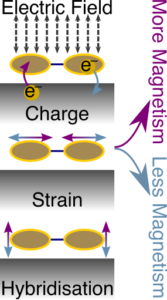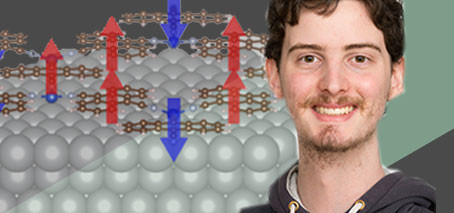- How substrates influence magnetism in 2D materials
- Interaction-induced magnetism in metal-organic frameworks on substrates

Theoretical modelling by Bernard Field (Monash University) and colleagues in the Faculty of Engineering (Department of Materials Science and Engineering) and Faculty of Science (School of Physics and Astronomy)
A new study at Monash University illustrates how substrates affect strong electronic interactions in two-dimensional metal-organic frameworks.
Materials with strong electronic interactions can have applications in energy-efficient electronics. When these materials are placed on a substrate, their electronic properties are changed by charge transfer, strain, and hybridisation.
The study also shows that electric fields and applied strain could be used to ‘switch’ interacting phases such as magnetism on and off, allowing potential applications in future energy-efficient electronics.
Turning magnetism on and off with substrates
Strong interactions between electrons in materials gives rise to effects such as magnetism and superconductivity. These effects have uses in magnetic memory, spintronics, and quantum computing, making them appealing for emerging technologies.
Last year, another study at Monash discovered strong electronic interactions in a 2D metal-organic framework. The researchers found signatures of magnetism in this material. They showed that this magnetism arose due to strong interactions that were only present when the non-magnetic components were brought together.
This material was grown on a metallic substrate. The substrate was important for the growth and measurement of the material.
Explainer: Metal-organic framework A crystalline material where organic molecules are connected by metal atoms. Metal-organic frameworks can show many different properties by changing the molecules or metal atoms.
“We observed this effect when the material was grown on silver, but not when it was grown on copper, despite them being very similar,” says Bernard Field (Monash), co-author of the earlier study and lead author of the current study.
“So that begged the question: Why did the material behave so differently on different substrates?”
The researchers simulated the metal-organic framework on many different substrates to determine under what conditions magnetism could emerge.
They also created a simple model which accurately described the physical phenomena in their atomic-scale simulations. This model allowed the team to quickly and easily explore a wider range of systems with fine control over the important parameters.

A 2D metal-organic framework (MOF) on a substrate. Strong electronic interactions in the MOF allow local magnetic moments (arrows) to form in the molecules.
Three key variables were found to determine the effect of substrates on electronic interactions: charge transfer, strain, and substrate hybridisation.
- Charge transfer is when a substrate gives or takes electrons from the 2D material. The effect of interactions was strongest when the material had one free electron per molecule.
- Strain is when a substrate stretches or squeezes the 2D material. When the material is stretched, electrons have difficulty moving between molecules and atoms, so they experience local interactions more strongly.
- Hybridisation is when the electronic character of the substrate and the 2D material are mixed due to coupling between them. Metallic substrates often have strong hybridisation, which can suppress magnetism. But insulating substrates, such as atomically-thin hexagonal boron nitride, have very weak hybridisation and preserve the electronic interactions in the material.
With this understanding of what the key variables are, it is possible to consider how to manipulate these variables to control the electronic interactions.

Substrates can change the magnetic properties of 2D MOFs via three key variables: charge transfer (which can be controlled by electric fields), strain, or hybridisation.
The study showed that an electric field could turn magnetism on and off by changing the charge transfer.
Electric fields are how existing transistors operate. Having electric control of magnetic phases is vital for using these materials in electronic devices.
The study also showed that applied strain could turn magnetism on and off. This could be achieved using piezoelectric materials. It is also an important consideration for flexible electronics.
“The team is continuing to investigate strong interactions in 2D metal-organic frameworks, which provide a rich platform to explore novel quantum physics applied for energy-efficient electronic devices,” says corresponding author Prof Nikhil Medhekar (Monash Department of Materials Science and Engineering), who led the study, “We are investigating more advanced methods for simulating strong interactions between electrons.”
“This work provides quantitative predictions, using diverse theoretical formalisms, on the electronic properties of low-dimensional nanomaterials on a wide range of substrates and conditions,” says co-author A/Prof Agustin Schiffrin (Monash School of Physics and Astronomy), who leads experimental research on these materials, “This can guide future real-world experiments, which is extremely valuable for experimental researchers.”
The study
“Correlation-induced magnetism in substrate-supported 2D metal-organic frameworks” was published in npj Computational Materials in November 2022. (DOI: 10.1038/s41524-022-00918-0)
This study was supported through the Australian Research Council (Centre of Excellence and Future Fellowship programs). Resources for numerical calculations were provided by the National Computing Infrastructure (NCI) and Pawsey Supercomputing Centre.
First principles theory studies at FLEET
Prof Medhekar’s team at FLEET utilises a variety of modelling techniques based on first principles to investigate links between atomic-level structure and electronic properties of a wide range nanomaterials, including the low-dimensional materials that are promising for the next-generation electronics technologies.
FLEET is an Australian Research Council-funded research centre bringing together over a hundred Australian and international experts to develop a new generation of ultra-low energy electronics.
More information
- Contact Prof Nikhil Medhekar (Monash University Department of Materials Science and Engineering) nikhil.medhekar@monash.edu
- Contact A/Prof Agustin Schiffrin (Monash University School of Physics and Astronomy) agustin.schiffrin@monash.edu
- Connect with FLEET on social media @FLEETCentre
- Visit Computational Materials Lab at Monash
- Discover Surface Nanophysics at Monash

